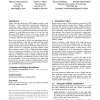Free Online Productivity Tools
i2Speak
i2Symbol
i2OCR
iTex2Img
iWeb2Print
iWeb2Shot
i2Type
iPdf2Split
iPdf2Merge
i2Bopomofo
i2Arabic
i2Style
i2Image
i2PDF
iLatex2Rtf
Sci2ools
101
click to vote
SIGMOD
2008
ACM
2008
ACM
OLTP through the looking glass, and what we found there
Online Transaction Processing (OLTP) databases include a suite of features -- disk-resident B-trees and heap files, locking-based concurrency control, support for multi-threading -- that were optimized for computer technology of the late 1970's. Advances in modern processors, memories, and networks mean that today's computers are vastly different from those of 30 years ago, such that many OLTP databases will now fit in main memory, and most OLTP transactions can be processed in milliseconds or less. Yet database architecture has changed little. Based on this observation, we look at some interesting variants of conventional database systems that one might build that exploit recent hardware trends, and speculate on their performance through a detailed instruction-level breakdown of the major components involved in a transaction processing database system (Shore) running a subset of TPC-C. Rather than simply profiling Shore, we progressively modified it so that after every feat...
Database | Online Transaction Processing | SIGMOD 2008 | Transaction Processing | Transaction Processing Database |
| Added | 08 Dec 2009 |
| Updated | 08 Dec 2009 |
| Type | Conference |
| Year | 2008 |
| Where | SIGMOD |
| Authors | Stavros Harizopoulos, Daniel J. Abadi, Samuel Madden, Michael Stonebraker |
Comments (0)

